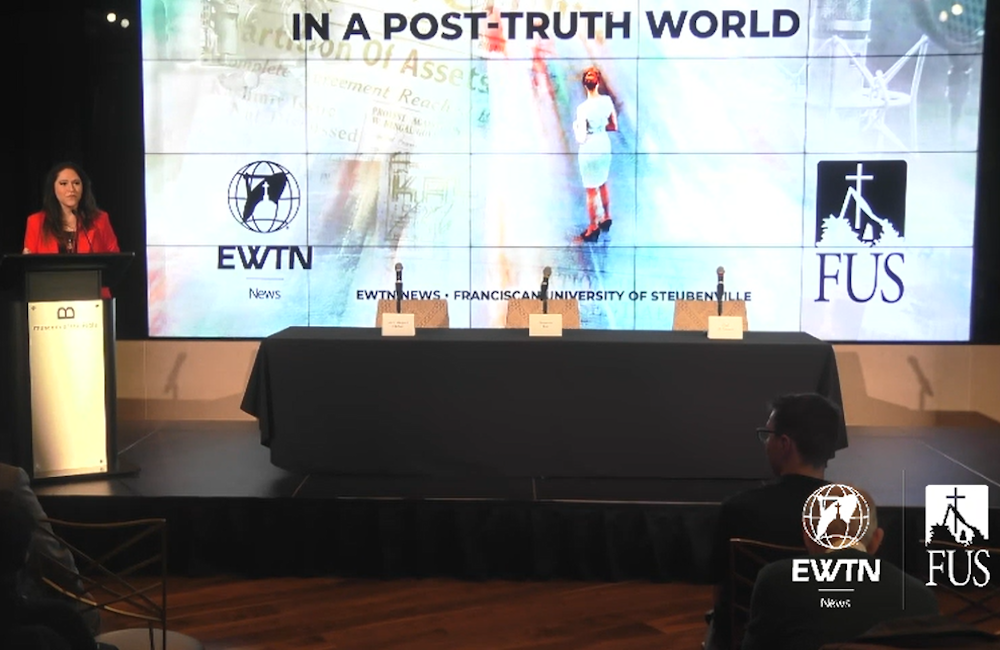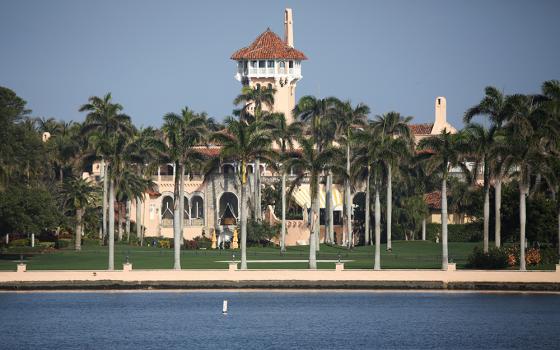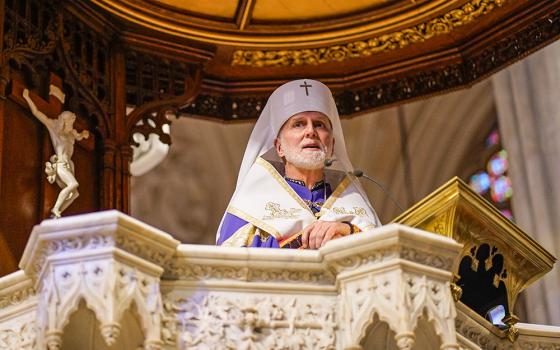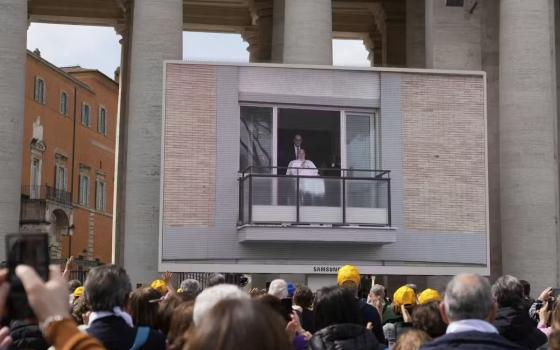
This is a screenshot of Word on Fire Catholic Ministries' website on May 5, 2022. The nonprofit global media apostolate was founded by Bishop Robert E. Barron of Winona-Rochester, Minnesota. (CNS photo)
Not long after Joe Biden became the nation’s second Roman Catholic president of the United States, I wrote for America magazine about something that had occurred to me many years earlier: Much of the difficulty about Catholics in U.S. politics owes to how worried I think our bishops are that they've lost control of the narrative. Because of changes in communications technology, media and how we live in this contemporary world, bishops and pastors are only one voice among many with the power to define what is "Catholic."
Catholics like President Joe Biden or former House Speaker Nancy Pelosi, who hold highly visible public offices, simply have a greater reach. Most Catholics probably would have trouble naming a bishop other than their own, and few outside the church can name any. The issue is both about ecclesiology and also about public theology. When I wrote about it for America, I put it in the form of a question: "Who owns the brand?" The honest answer probably is that it no longer is owned (at least in the same way it used to be) by the successors of the apostles, our bishops and pastors. This is not a new problem. It has been taking shape since the beginning of the television age and the Kennedy presidency.
But there also is a far more troubling way that this transformation has manifested itself. Across the last 20 years, the Catholic brand has come to be appropriated in a more worrying way by organizations with uncertain ties to the structure of the church. The most prominent of these organizations is the Eternal Word Television Network, or EWTN, but there are many others.
An important word here needs to be said about the relationship of EWTN and the others to the church because I doubt many people understand it. In a canonical sense, some of these organizations seem to have an official relationship to the church. EWTN, for example, appears to be a public association with a mission exercised under ecclesiastical supervision. Word on Fire certainly operates in a like manner, not least because the local bishop where Word on Fire operates also is that ministry's founder, who remains one of its board members.
Others like CatholicVote and Catholics for Catholics would seem to have a more distant relationship to the church canonically — if they have any relationship at all. As a legal matter, anyone can create a corporation or achieve nonprofit tax-exempt status with a Catholic-sounding name. The IRS does not seek the permission of bishops when that happens. It is more than possible for a group to call itself Catholic and have no canonical relationship to the church at all.
No matter whether they are attached canonically to the church or not, what all of these organizations share in common is the extraordinary amount of money that pours into them. NCR's Heidi Schlumpf has done important reporting about this, but the information also is publicly available to anyone who takes time to search publicly available tax filings.
For example, tax filings reveal that during the period between 2002-2022 EWTN alone raised nearly $1 billion as "contributions, gifts, and grants." That is a lot of money. And, EWTN is hardly alone.

U.S. dollars are seen in this illustration photo. (OSV News/Reuters/Yuriko Nakao)
What is remarkable is that those same last two decades have seen parish and diocesan collections plummet. A 2015 study published in the Journal of Public Economics found long-term declines of contributions to the Catholic Church following the revelations of the sexual abuse crisis going back to the 1980s. After the 2018 revelations about Theodore McCarrick, a Pew Research study found a quarter of U.S. Catholics began attending Mass less often and giving less. A post-pandemic study published by Villanova University found that the combination of these effects had become profound: fewer parishioners are carrying the burden to support ministries with their contributions. While there has been some rebound since pandemic-era dips, the Villanova study found that U.S. parishes on the whole have an average 11% less to spend in their budgets than they did before the pandemic. And, of course, the decline had been underway for decades already by that point.
The overall picture is familiar and alarming. We know that the church in the U.S. is shrinking, parishes are merging, and ministries are closing. What is remarkable is to hold that fact next to the explosive growth in fundraising among Catholic groups like EWTN or Word on Fire. What seems clear is that at least some of the money Catholics once gave to parishes and dioceses now is being directed toward these other groups. And, the effects are something we should take seriously.

Montse Alvarado, president and chief operating officer of EWTN News, addresses the audience during the "Journalism in a Post-Truth World" conference, sponsored by EWTN and Franciscan University March 10-11, 2023, at the Museum of the Bible in Washington, D.C. (NCR screenshot)
First, there is simply the scale of the money we are talking about. The year-to-year growth in giving to these groups is an almost unbroken, upward line. The Becket Fund for Religious Liberty increased its fundraising from $6.2 million in 2018 to $11 million in 2022. EWTN went from $57.2 million in 2018 to $89.5 million in 2022. Fidelis (CatholicVote) from $3.3 million to $9.3 million. Lifesite from $1.6 million to $5 million. Word on Fire from $1.5 million to $11.4 million.
It is particularly easy to see a pattern of rapid growth in the last few years. Becket is at 153% of its pre-pandemic fundraising. EWTN is at 138%. Fidelis is at 227%. Lifesite is at 267%. And, Word on Fire is at 476%. Dioceses and parishes did not fare so well in those same years.

A file photo shows an American flag flying outside a Catholic church in New York. (OSV News/Long Island Catholic/Gregory A. Shemitz)
Then, there is what these groups are doing with all of that money, and this is the important point. Some of these groups are promoting an evangelizing or spiritual message. Some others have plainly partisan goals. In some cases that line is blurry. But in all cases, these groups are penetrating the consciousnesses of U.S. Catholics with much greater effectiveness than any bishop who is burdened not just by declining collections but also who must support ministries of care that do not trouble any of these groups.
While bishops and pastors struggle to sustain schools and soup kitchens — indeed, while the U.S. bishops contemplate shuttering the Catholic Campaign for Human Development — Catholics contribute hundreds of millions of dollars each year to these (and many other) activist and social communication organizations that have redefined the Catholic "brand" in the United States. Often, that brand identity reflects cultural anger and a desire to be a "sign of contradiction" set against the world.
EWTN reaches tens of millions of households. Even more directly and intimately, the internet brings EWTN and all of these other "Catholic" organizations to our inboxes and to the phones in our pockets. Suddenly, technology and vast sums of money have created a world where ordinary Catholics can reach beyond their pastors to shop for the Catholic "brand" that suits them best.
Advertisement
In turn, those organizations have found a power to reshape the Catholic Church in the United States. With sophisticated marketing and production values as slick as anything produced by Hollywood, they have shifted the perspectives of individual Catholics on a wide scale in ways that have deepened our divisions and helped encamp us against each other. They also have completed that work begun decades ago: Bishops no longer drive the narrative of the church in the way that they used to.
The "brand" now is firmly under new ownership.
When we look around at the church in the United States today, it is easy to see the effects of all this. It is somewhat more difficult to spot the cause. This problem these organizations represent is subtle. But there is nothing subtle about the power that these organizations represent or the challenge that they pose to the structures of the church as we have known it for centuries.







